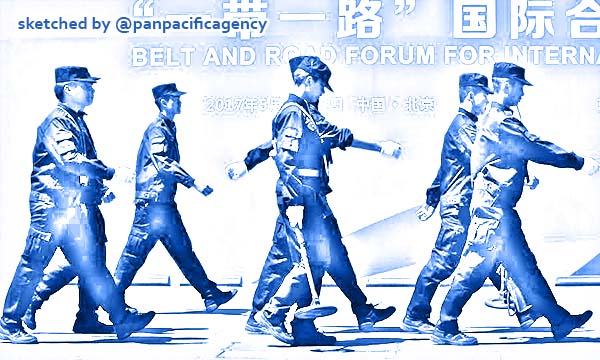[Analytics] West fails to see greater BRI vitality after epidemic

Security guards walk past a billboard for the Belt and Road Forum for International Cooperation in Beijing on May 13, 2017. Photo: AFP/Wang Zhao. Sketched by the Pan Pacific Agency.
Is the China-proposed Belt and Road Initiative (BRI) under threat because of the ongoing novel coronavirus (COVID-19) epidemic? The topic has surfaced in Western media. As usual, as those media fan the flames of anxiety, they miss the big picture. Ai Jun specially for the Global Times.
No doubt the COVID-19 outbreak has turned into a challenge for the BRI, with some projects in danger of falling behind schedule. As Reuters noted, “Chinese workers cannot get to overseas projects… Many factories in China remain closed,” which caused “disruptions in industrial production and the supply chain.”
Yet the point they have missed is the projects under the framework of the BRI meet the needs of an increasing number of countries – common development. Such vision and pursuit will not change due to the epidemic in China. Nor will China make major adjustments over the initiative because of the epidemic. As long as the common wish is in line with the general development trend, the BRI will only keep going forward despite occasional bumps on the road.
At the moment, China is assessing the difficulties that are confronting the BRI. It is coordinating with countries along the route over challenges, including supplies and the arrangement of personnel in key projects, based on other countries’ requirements over disease prevention and control.
Take the China-Laos railway, a flagship project under the BRI. China Railway Materials Group Corporation, a state-owned Chinese company, has coordinated the resumption of work of relevant upstream and downstream factories to ensure the supply of necessary materials through not only rail but also sea transport.
In the face of the epidemic, many other state-owned enterprises have also adjusted their production and operation strategies, and are attaching greater significance to making sure their orders with foreign firms can be completed on time.
The Chinese Foreign Ministry should also proactively coordinate with other countries to help BRI projects proceed on schedule, help resolve the obstacles that have affected local industrial chains and minimize COVID-19’s influence on BRI projects.
The BRI is not a temporary initiative, but a long-term development plan. It is not China’s own program, but about the future of all countries along the route. Studies have shown that the average airport density of the area along the BRI is approximately one-third of the other countries, density of railways among BRI countries about one-sixth of Europe. So long as the countries are yearning for development, they are in huge need of the BRI.
Be it the Jakarta-Bandung high-speed rail in Indonesia, the Gwadar Port in Pakistan or the China-Myanmar oil and gas pipeline, those are not only the China-invested projects, but have also brought infrastructure and employment that the countries desire.
The BRI has brought more clean water, electricity, roads, bridges, schools, hospitals and industrial parts to quite a few countries and regions. It helps allocate local resources in a more efficient way, integrate markets and industrial chains among different countries. The cities, which are becoming transport hubs along the route, are emerging sharply, just like Shenzhen after reform and opening-up.
Economic gains and development opportunities are possible for all. This is the reason the BRI has attracted more and more countries. If such nature of the BRI does not change, the development of its projects will not encounter major blows. China has full confidence and the ability to win the battle against the COVID-19. It also believes that after the epidemic, the BRI will show greater vitality. This is the big picture that Western media fail to see.